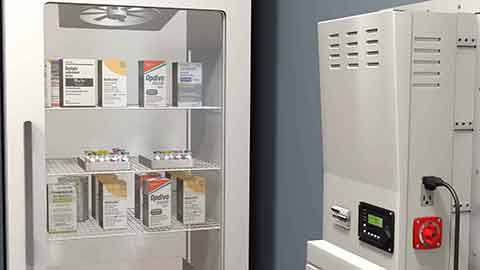Battery Powered Backup Generator Maintenance Checklist.
[Before we get Started…if you’re just looking to skip the details download a guide really quick, click here. You’re welcome.]
Among the many characteristics that make owning, operating, and deploying battery powered backup a far less tedious proposition than a gas-powered or diesel generator is the maintenance—or lack thereof. Battery-powered rechargeable generators by their nature have no need for and contain virtually no moving or lubricated components.
For end users this mean almost no preventative maintenance needs to be performed except periodic testing. Additionally, The only major maintenance item one can expect in their cost of ownership is replacing the batteries in your unit—though recommend only replacing these approximately every 4 years. This interval will ensure sustained optimal system performance.
However, when performing the maintenance that WILL be necessary for a battery backup generator, many questions arise—such as:
“How often does battery generator testing need to be done?”
“What signs of wear and tear should you look for when testing a generator?”
“Who should perform the test of my facility’s rechargeable generator?“
And while testing should be easy to complete, mistakes can still be made during the process.
Below we’ll go step-by-step and break down everything you need to know about performing regular testing and maintenance for your battery powered backup generator
Note: While every manufacturer has different products that behave in their own unique ways these steps should be ubiquitous enough to apply to most every system. For any specific information please contact your unit’s manufacturer. For specific information about testing a MediProducts unit, click here to find a PDF version of our in-depth guides.
Backup Battery Generator Testing Intervals
First, you’ll need to decide what kind of test you’ll be performing on your uninterruptible power supply system.
When testing our own systems, MediProducts recommends both Weekly function tests as well as Monthly runtime tests—though we would encourage similar regular testing intervals for everyone regardless of manufacturer.
Weekly Function Tests
These should be clean, quick and easy. A weekly testing of your system just makes sure that the inverter switches on, the batteries function properly, and power is quickly being delivered to your appliances—taking no more than minute total. This short, but important test ensures all stages of the power chain are working as expected in case of emergency and aids in uncovering any potential issues as quickly as possible.
Monthly Runtime Tests
While they may be a bit longer than weekly function tests, monthly runtime tests ensure that your system is providing emergency backup power for as long as you originally intended and you’ll have the maximum amount of time available to you should you experience an unexpected power outage situation.
We recommend when performing monthly tests, to allow your system to run off of purely battery power for 20 percent of your systems total runtime—for example, a system rated for 10 hours would be best suited to run a 2 hour test once a month.
Not only ensuring your systems will be able to run for as long as necessary, this test will help to cycle power and maintain optimal battery heath—preventing degradation and helping to extend their life cycle.
Backup Battery Generator Inspection Checklist: Step-By-Step
Before Testing: Complete a visual inspection of your unit searching for any signs that performance may be compromised including but not limited to:
Fluid Leaking, Frayed Wiring, foul smells from the exhaust system, or significant damage to the cabinet outside of normal wear and tear. if so please contact your facility's on-site manager immediately or contact your manufacturer for further questions and concerns.
Because they are so similar, the following steps are applicable to either weekly or monthly tests and are as follows:
1) Plug-in the power cord and power up the system if this has not already been done prior-to.
2) Check any LED panel or indicator lights for a sign that the unit is inverting.
Note: For a MediProducts system there is often a small LED light labeled “Inverting” located on the panel that will turn on. This means your system is receiving outlet power and may soon change to “Bulk” or “Float” charging modes depending on the current state of your batteries.
3) Plug in the desired appliance or appliances into the unit’s output (this can be outlets, USB ports, etc.)
4) Observe if appliance functions properly while plugged into battery backup system while the latter is plugged into the wall.
Note: If you are powering a refrigerator or freezer, make sure to run the test long enough for the compressor to turn on. This process can be expedited by opening the door of your appliance—though be careful, this could lead to unintended temperature excursions.
5) If all is functioning properly, unplug backup power system from utility power or wall outlet, creating a simulated outage situation.
Note: If your backup power system is integrated directly into your facility’s power circuits, you may need to cut power by directly switching off the associated breaker/fuse via the appropriate electrical panel.
6) Observe both your systems LED Panel and Appliance. If functioning properly, your appliance should continue running as normal and your system should give another “inverting” indication or something of the like communicating that it is currently providing power via battery and not utility.
Note: if performing a monthly runtime test, it is recommended during the course of testing (which may last a few hours) you dedicate someone to regularly observing the system to ensure that if a challenge occurs your appliance can be quickly returned to utility power.
7) Restore utility power to your battery backup unit by once again plugging it into the wall (or for a hardwired system turning on its breaker panel switch).
8) Check the LED panel or indicator lights of your unit. It should signal that a sign that it is now “charging” or otherwise currently accepting utility power.
9) Test Complete.
Once your test has been completed, we highly recommend maintaining meticulous records of your systems in order to ensure quick discovery of any potential issues as well as tracking which personnel in your facility’s is interacting with the backup unit.
Rechargeable Backup Generator Safety Checklist & Testing
In order to make testing and maintenance of your rechargeable generator EVEN EASIER than it already is, we’re providing you with both a free step-by-step checklist—same as the one above— as well as with a free testing log so you can track your weekly function and monthly runtime tests—and keep you on track by helping to see if you’re actually doing them when you tell yourself you’re going to.
Learn More About Battery Backup Power
To answer even more of your questions and find additional solutions to problems that could affect your medical facility or laboratory, check out these other articles from the Medi-Products blog and the Medi-Products Learning Center:
Testing and Maintenance Schedule For MediProducts Battery Backup Systems
How to Perform a System Test of a MediProducts Battery Backup Generator
What are the Maintenance Costs Associated With Battery Powered Generators?


